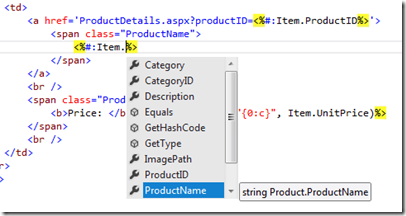Getting Started with ASP.NET 4.5 Web Forms
The best way to learn what’s new in ASP.NET 4.5 Web Forms, is to work through the latest tutorial series by Erik Reitan: Getting Started with ASP.NET 4.5 Web Forms.
The 10 tutorials in the series progressively guide you through building a Web Forms application, which is a simplified example of a store front web site that sells items online. Each tutorial builds on the previous tutorial. When you’re finished, you’ll be familiar with common ASP.NET concepts, as well as many of the new features available in ASP.NET 4.5, including effective use of the new model binding features.
In addition, you’ll learn about, Entity Framework Code First, unobtrusive validation, the Anti-XSS library, HTML5, data annotations, Local DB, value providers, PayPal integration, ASP.NET Membership, URL routing, and more.
Here’s an outline of the tutorial series:
Introduction and Overview
- Introduction
- Audience
- Application Features
- Application Scenarios and Tasks
- Overview
- Prerequisites
- Download the Sample Application
- Tutorial Support and Comments
Create the Project
- Creating the Project
- Reviewing the Project
- Running the Default Web Application
- ASP.NET Web Forms Background
- Web Application Features in the Web Forms Application Template
- Touring Visual Studio
- Summary
- Additional Resources
Create the Data Access Layer
- Creating the Data Models
- Configuring the Application to Use the Data Model
- Building the Application
- Summary
- Additional Resources
UI and Navigation
- Modifying the UI
- Updating the Master Page
- Adding Image Files
- Adding Pages
- Updating the StyleSheet
- Modifying the Default Navigation
- Adding a Data Control to Display Navigation Data
- Linking the Data Control to the Database
- Running the Application and Creating the Database
- Reviewing the Database
- Summary
- Additional Resources
Display Data Items and Details
- Adding a Data Control to Display Products
- Displaying Products
- Adding Code to Display Products
- Running the Application
- Adding a Data Control to Display Product Details
- Running the Application
- Summary
Shopping Cart
- Creating a Shopping Cart
- Managing the Shopping Cart Business Logic
- Creating the Shopping Cart Class
- Creating the Add-To-Cart Functionality
- Creating the Shopping Cart UI
- Retrieving the Shopping Cart Items
- Adding Products to the Shopping Cart
- Testing the Shopping Cart
- Calculating and Displaying the Order Total
- Modify the Shopping Cart Display
- Testing the Shopping Cart Total
- Adding Update and Checkout Buttons to the Shopping Cart
- Updating and Removing Shopping Cart Items
- Adding a Shopping Cart Counter
- Testing the Completed Shopping Cart
- Summary
- Addition Information
Checkout and Payment with PayPal
- Adding Order Tracking
- Adding Checkout Access
- Enabling Logins from Other Sites Using OAuth and OpenID
- Modifying Login Functionality
- Migrating the Shopping Cart
- Updating the Database Connection
- Integrating PayPal
- Running the Application
- Reviewing the Database
- Summary
- Disclaimer
Membership and Administration
- Adding an Administrator
- Restricting Access to the Administration Page
- Including Administrator Navigation
- Enabling Product Administration
- Running the Application
- Summary
- Additional Resources
URL Routing
- ASP.NET Routing Overview
- Mapping and Registering Routes
- Retrieving and Using Route Data
- Running the Application
- Summary
ASP.NET Error Handling
- Overview
- Adding Error Logging Support
- Adding an Error Page
- Displaying Unhandled Error Messages for the Application
- Including an Exception for Testing Purposes
- Adding Application-Level Error Handling
- Adding Page-Level Error Handling
- Removing the Exception Used for Testing
- Adding Code-Level Error Logging
- Inspecting the Error Logging Information
- Safe Error Messages
- Using ELMAH
- Viewing the ELMAH Log
- Summary
- Conclusion
- Additional Resources
- Acknowledgements


 Light
Light Dark
Dark
0 comments